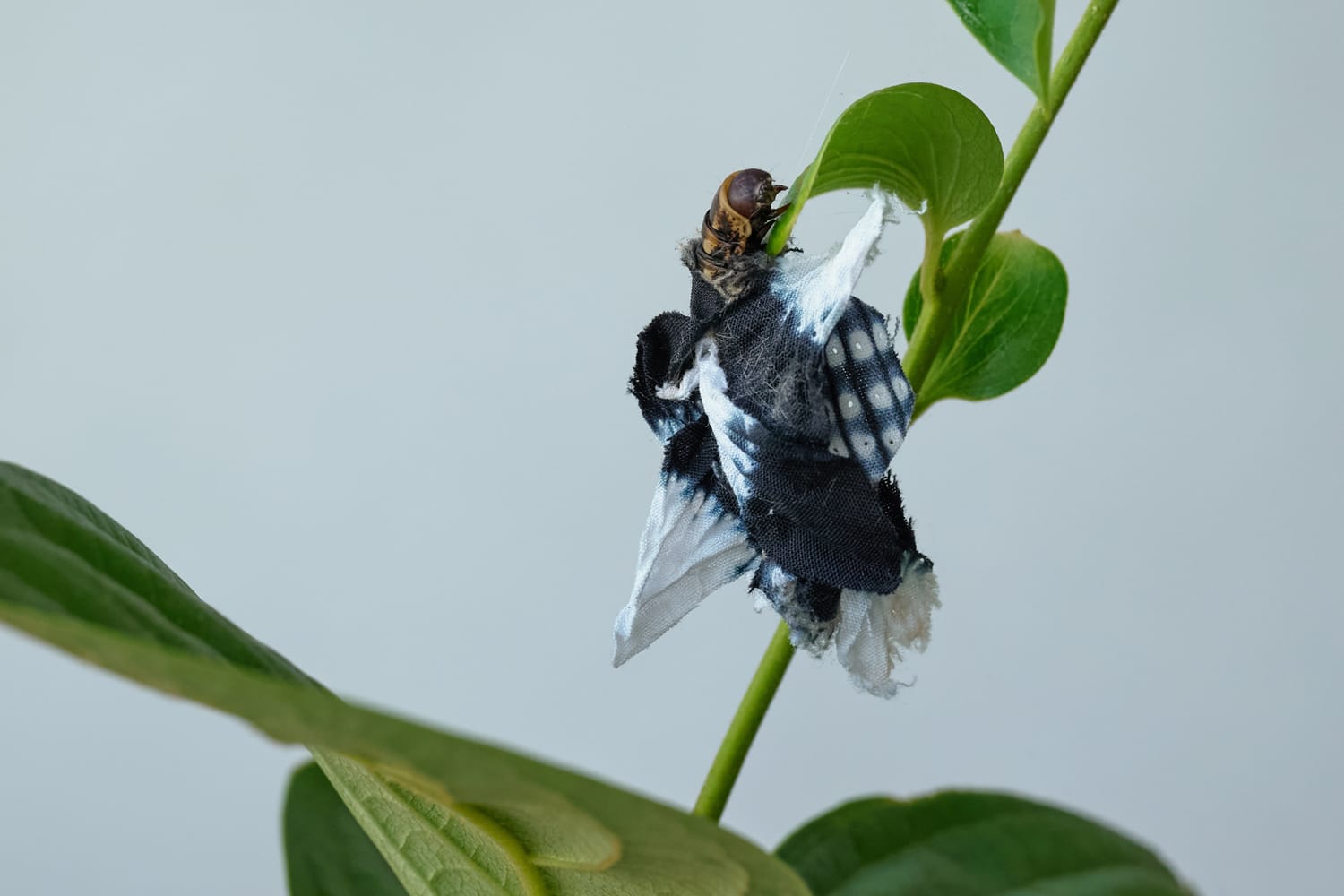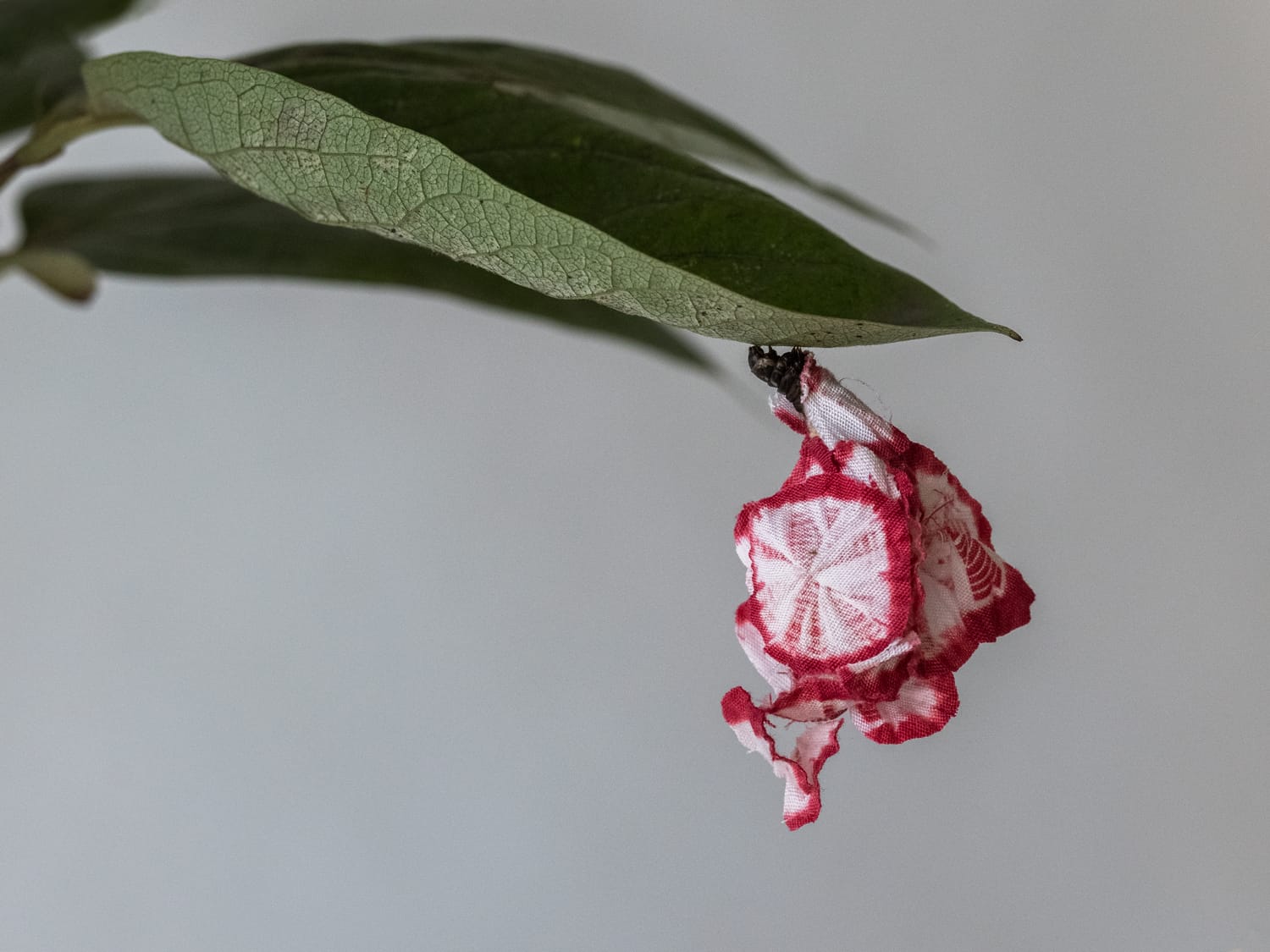Passing her a piece of cloth彼女に布をわたしてみる
2022
4K video (Consists of 9 pieces, [looped]), bagworm, cotton(Arimatsu-Narumi Shibori), tree branch
Exhibition view: Aichi Triennale 2022 "STILL ALIVE" (30 July–10 October 2022).
芸術監督:片岡真実(森美術館館長、国際美術館会議(CIMAM)会長)
https://aichitriennale.jp/artists/aki-inomata.html
有松絞り|久野染工場
Arimatsu-Shibori (Arimatsu tie-dye) | Shibori-Dyeing Kuno-Studio
ミノムシ生態アドバイス|新津修平(東京都立大学)、鈴木誉保・岩崎渉(東京大学)
Advises on bagworm ecology | Shuhei Niitsu (Tokyo Metropolitan University), Takao K. Suzuki and Wataru Iwasaki (The University of Tokyo)
団扇製作|蜂屋佑季(蜂屋うちわ職店)
Prodction of Uchiwa (round fan) | Yuki Hachiya (Hachiya-Uchiwa Arts&Crafts)
コーディネーター|小田鮎子(あいち2022)
Coordinator | Ayuko Oda (Aichi Triennale 2022)
メイキング動画 撮影・編集|朝岡英輔
Making movie / director of photography and editing | Eisuke Asaoka
メイキング動画 整音|伊藤豊(イトウ音楽社)
MA of making movie | Yutaka Ito (Ito Ongaku-sha)
動画編集協力|須賀亮平
Cooperation of video editing | Ryohei Suga
プログラミング|竹内均
Visual Programming | Hitoshi Takeuchi
ミノムシ保存修復アドバイス|吉岡智代
Advises on conservation and restoration | Tomoyo Yoshioka
制作補助|柴原聡子・吉野谷綾子
Production assistants | Satoko Shibahara, Ayako Yoshinoya
協力|Maho Kubota Gallery
Cooperation | Maho Kubota Gallery
謝辞|岩崎秀雄(早稲田大学)
Special thanks | Hideo Iwasaki (Waseda University)
AKI INOMATA is known for her observations of the various distinctive characteristics of life in the natural world, and her works made in “collaboration” with non-human creatures such as hermit crabs, beavers, and pearl oysters. For this exhibition, the artist worked with Shibori-Dyeing Kuno-Studio to create a kind of confusion of the tie-dyeing techniques developed in Arimatsu and the techniques used by minomushi bagworm moth larvae to create their nests. In Arimatsu-Narumi Shibori, the cloth is tied with thread, sewn and tightened, to create areas that will not take on the dye, and then dyed with a variety of patterns. INOMATA felt that this cloth in its wrapped state resembled a bagwormʼs protective cases, so she gave bagworms some Arimatsu tie-dyed cloth and asked them to make protective cases with it.
The House of Oka where INOMATA exhibits her work is a shibori tie-dye wholesaler in Arimatsu founded in the late Edo period. On display in this former workshop space is a video work entitled Passing her a piece of cloth (2022), which depicts a bagworm eating leaves while wearing a beautiful Arimatsu-Narumi Shibori protective cases. In this space with a high-ceilinged skylight, a bagworm wearing an Arimatsu-Narumi Shibori coat is displayed attached to a twig. It is said that more than 100 different patterns were created as Arimatsu-Narumi Shibori was developed, and some of the techniques used in this work are Yatara Miura Shibori, Karamatsu Shibori, Nuisuji Mokume Shibori, Boshi Shibori, Hinode Shibori, Kikai Kumo Shibori, and others.
INOMATA has also developed a new tie-dye technique based on that seen on the wings of the bagworm moth after it emerges from its chrysalis. This pattern is taken from the fungus-feeding bagworm and the wood boring moth, a species that is evolutionarily older than the common bagworm moth, and whose adult females also turn into moths and fly with their wings. This new bagworm moth pattern has been made into a fan and displayed together with chests of drawers and other objects from the Oka familyʼs Shinzashiki. The wing-shaped fan creates a breeze, as if the bagworm moth were flying.(*1)
*1──Aichi Triennale 2022 official website : https://aichitriennale.jp/en/artists/aki-inomata.html
AKI INOMATAは、自然界における様々な生命の特性を観察し、ヤドカリ、ビーバー、真珠貝など人間以外の生きものと「共同で制作」した作品で知られています。本展では、有松で発展してきた絞り染めの技術と、ミノガ(箕蛾)の幼虫、ミノムシが巣をつくる技術の混淆を、久野染工場の協力を得て実現しました。有松・鳴海絞りでは、布を糸でくくり、縫い締めるなどの方法で染まらない箇所をつくり、多彩な模様を染め上げます。くくられた状態の布がミノムシの蓑に似ていると感じたINOMATAは、有松絞りの生地をミノムシに与え、蓑(巣筒)をつくってもらいました。
彼女が展示する岡家住宅は、江戸時代末期の有松の絞問屋です。この元作業場空間に、有松・鳴海絞りの美しい蓑を纏いながら葉を食べるミノムシの映像作品《彼女に布をわたしてみる》(2022)が展示されています。また、高い天窓のある空間には、有松・鳴海絞りで蓑をつくったミノムシが小枝についた状態で展示されています。有松・鳴海絞りが発展するなかで100種類以上の模様が生みだされたといわれていますが、本作には「やたら三浦絞り」「唐松絞り」「縫い筋杢目絞り」「帽子絞り」「日の出絞り」「機械蜘蛛絞り」などが使われています。
さらにINOMATAは、ミノムシが羽化した後のミノガの翅に見られる模様をモチーフに、新しい絞り染めの技法を考案しました。その模様は一般的なミノムシよりも進化的に古い種で、成虫になるとメスも蛾となり、翅をもって飛翔するキノコヒモミノガ、ヒモミノガから採られています。この新しいミノガ絞りを団扇に仕上げ、岡家の新座敷にあった箪笥などとあわせて展示しています。翅形の団扇は、あたかもミノガが翅を動かすようにして風を起こします。
(あいち2022公式ウェブサイトより引用)




